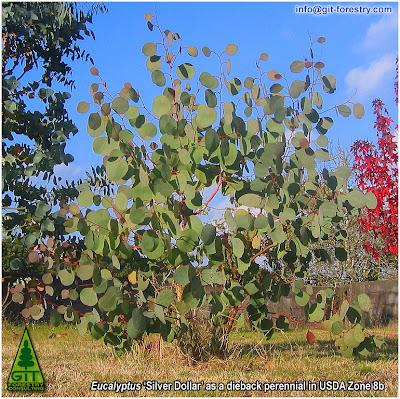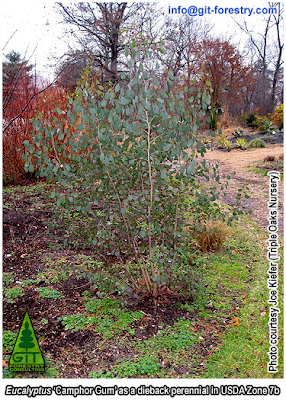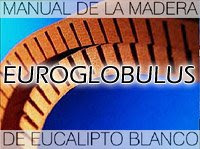Pictured below, three examples of Eucalyptus growing as ornamental plants in gardens where restrictive winter events lead to aerial part loss and natural regeneration from coppice favours annual regrowth.
 Fig 1: Yearly growth from coppice in Eucalyptus 'Silver Dollar', borderline cold hardy Eucalyptus for USDA Zone 8b (Click image to enlarge)
Fig 1: Yearly growth from coppice in Eucalyptus 'Silver Dollar', borderline cold hardy Eucalyptus for USDA Zone 8b (Click image to enlarge)As we have seen previously in EUCALYPTOLOGICS, many Eucalyptus species have naturally developed an ability to survive events that destroy their aerial part. In their natural habitat fire has been the main factor that lead to some species becoming vigorous coppicers thanks to a progressive culling out of non fit strains.

Fig 2: Yearly growth from coppice in Eucalyptus 'Omeo Gum', borderline cold hardy Eucalyptus for USDA Zone 7b (Image courtesy of Triple Oaks Nursery & Herb Garden, NJ)
Human driven introduction of Australian Eucalyptus as garden elements to areas where winters are more restrictive than in their natural habitats can lead to different results. When the chosen species is cold hardy enough for its new habitat, it tends to grow freely and attain its normal size and growth habit. When it is too tender for its new habitat, total loss can be the result after a bad winter. But when it is a borderline species, and a good coppicer, it can behave like an annual perennial, shooting every spring and growing to a limited size before next frost events wipe it out again. Another example of eucalypt resurrection, where frosts play the role of fire, just with a higher frequency.

Fig 3: Yearly growth from coppice in Eucalyptus "Camphor Gum", borderline cold hardy Eucalyptus for USDA Zone 7b (Image courtesy of Triple Oaks Nursery & Herb Garden, NJ)
Some advantages of cold hardy ornamental Eucalyptus as annual perennials
- Natural size control mechanism for species that could become excessively big sized if cultivated small gardens
- Display of juvenile foliage every year, excellent option for those species having in it its major ornamental features
- Additional size control via pollarding or pruning is possible after milder than usual winters
- Makes growing some of the cold hardiest species of Eucalyptus possible in very restrictive climates (USDA Zones 7b and 6a in some cases)
Some disadvantages of cold hardy ornamental Eucalyptus as annual perennials
- Nutrient cycle disrupted for the yearly loss of aerial parts, being fertilising a good corrective measure in the long term
- Possibility of decline in coppice vigour in the long term
- Fragility of new shoots in case of late sudden and heavy frost events
- Little chances of flowering and seed set
- Coppice ability is not unlimited, so sooner or later plant replacement might be necessary even with the best care
Some advice to promote good coppice in cold hardy ornamental Eucalyptus
- Choose Eucalyptus species that are reasonably cold hardy for your conditions
- Choose Eucalyptus species that are reliable coppicers
- Add a thick layer of protective mulching during the worst of winter to avoid ice induced injuries to the base of the trunk or to the lignotuber
- Pay attention to good weeding so the basal area of the eucalypt is well exposed to light to aid quick growth in new shoots from coppice once frost season is over
- Try to remove the dead aerial part (dead wood) during late winter or better once frost season is over to encourage regrowth from lignotuber instead of regrowth from the naked buds located in branchlet axils
- Keep an schedule for organic or mineral soil fertilization to avoid nutrient depletion or to replenish easily assimilable soil nutrient pools in the long term
- Keep good irrigation during dry spring spells and/or summer drought in arid areas to encourage bigger annual sizes
![]() Subscribe to receive EUCALYPTOLOGICS via RSS
Subscribe to receive EUCALYPTOLOGICS via RSS
© 2007 Gustavo Iglesias Trabado. Please contact us if you want to use all or part of this text and photography elsewhere. We like to share, but we do not like rudeness.



































![Validate my Atom 1.0 feed [Valid Atom 1.0]](http://gus.iglesias.googlepages.com/valid-atom.png)


















1 Comments by our readers :::
I have played with eucs for 3 years now. The dollar gum "baby blue" comes back every year with heavy mulch.
Send a comment to EUCALYPTOLOGICS